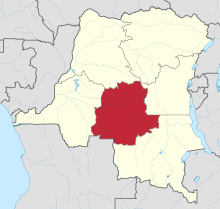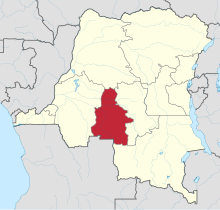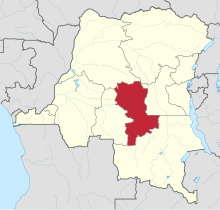Kasaï was a province of the Belgian Congo and the successor Republic of the Congo (Léopoldville).



Location
editKasaï was named after the Kasai River, a major left tributary of the Congo River that provides access to the region. By 1910 a factory of the Kasai Company had been established near Misumba, which had about two thousand inhabitants.[1] The company had made successful trial rubber plantations.[2] The company also bought rubber and ivory from the local people, some of whom used it to buy liquor from the Portuguese territory (Angola).[3]
History
editIn 1914 the Belgian Congo was organized into four large provinces: Congo-Kasai, Équateur, Orientale Province and Katanga.[4] in 1933 they were reorganized into six provinces, named after their capitals, and the central government assumed more control. Congo-Kasai was divided into the new provinces of Léopoldville and Lusambo, named after the city of Lusambo. In 1947 Lusambo Province was renamed to Kasaï.[5]
Kasaï became an autonomous province of the Congo republic on 30 June 1960.[6] On 14 August 1962 Kasaï was divided into five new provinces: Lomami, Luluabourg, Sankuru, Sud-Kasaï and Unité Kasaïenne. On 25 April 1966 Luluabourg and Unité Kasaïenne were united to form Kasaï-Occidental, while Lomami, Sankuru, and Sud-Kasaï were united in the new province of Kasaï-Oriental.[6]
See also
editNotes
edit- ^ Torday 1910, p. 33.
- ^ Torday 1910, p. 45.
- ^ Torday 1910, p. 51.
- ^ Bruneau 2009, p. 7.
- ^ Bruneau 2009, p. 8.
- ^ a b Congo (Kinshasa) Provinces.
Sources
edit- Bruneau, Jean-Claude (30 June 2009), "Les nouvelles provinces de la République Démocratique du Congo : construction territoriale et ethnicités", L'Espace Politique, 7 (2009–1), doi:10.4000/espacepolitique.1296, retrieved 2020-08-08
- "Congo (Kinshasa) Provinces", Rulers.org, retrieved 2020-08-05
- Torday, E. (July 1910), "Land and Peoples of the Kasai Basin", The Geographical Journal, 36 (1), The Royal Geographical Society (with the Institute of British Geographers): 26–53, doi:10.2307/1777651, JSTOR 1777651, retrieved 2020-08-08